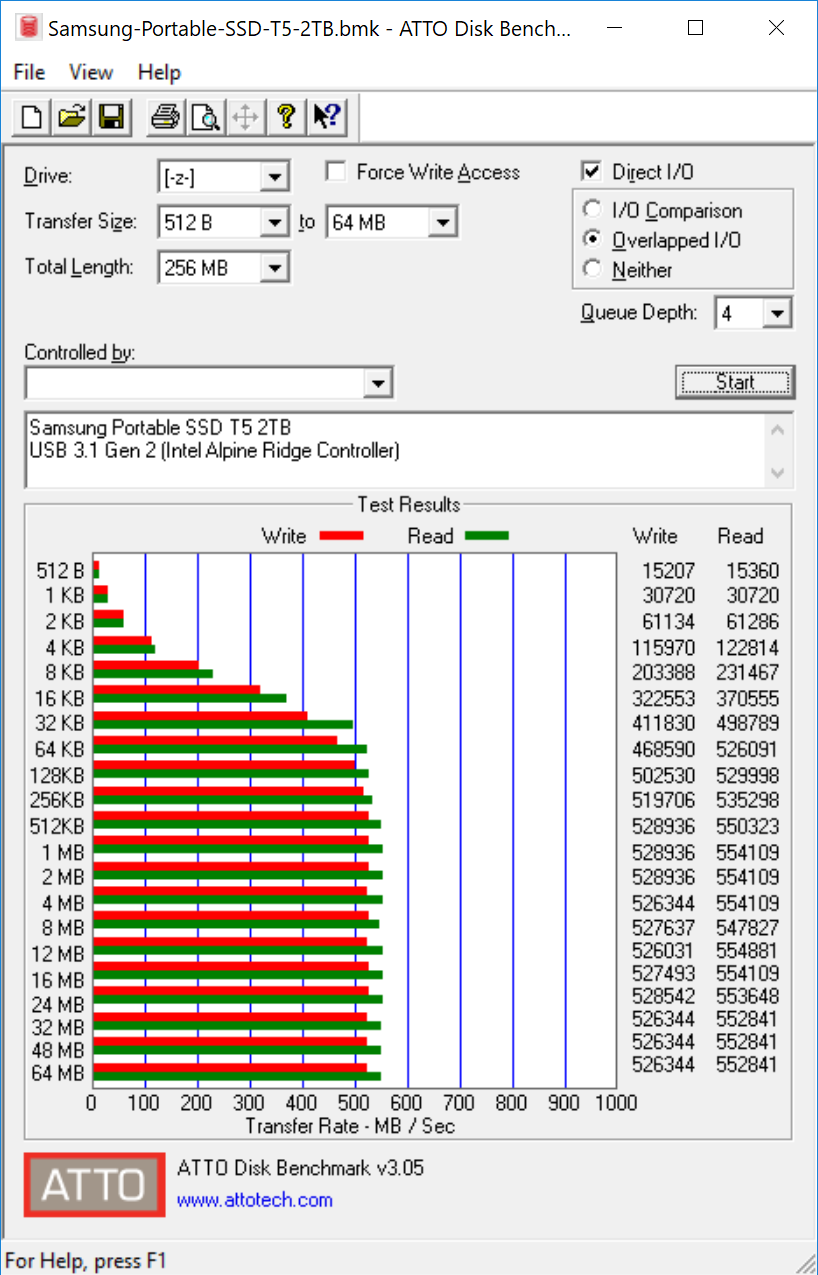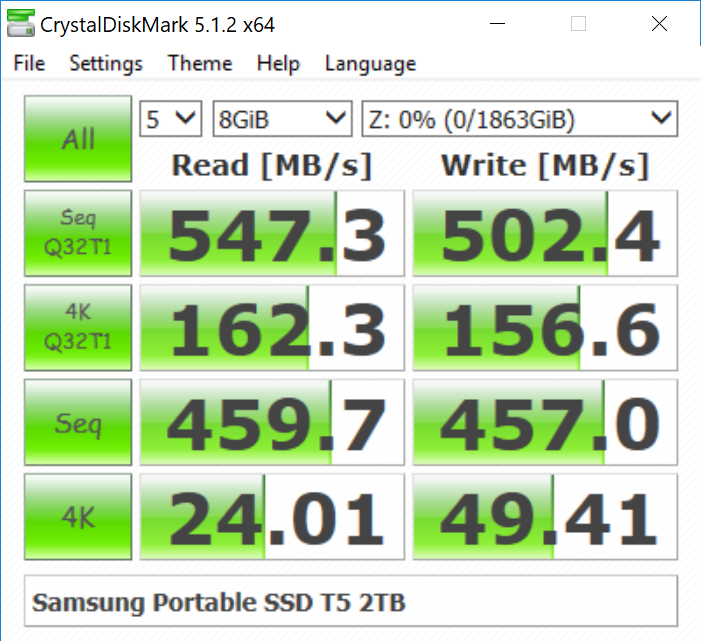Samsung Portable SSD T5 Review: 64-Layer V-NAND Debuts in Retail
by Ganesh T S on August 15, 2017 10:00 AM ESTSynthetic Benchmarks
Various synthetic benchmarks are available to quickly evaluate the performance of direct-attached storage devices. Real-world performance testing often has to be a customized test. We present both varieties in this review, starting with the synthetic benchmarks in this section. Prior to covering those, we have a quick look at our testbed setup and testing methodology.
Testbed Setup and Testing Methodology
Evaluation of DAS units on Windows is done with the testbed outlined in the table below. For devices with a USB 3.1 Gen 2 (via a Type-C interface) connections (such as the Samsung Portable SSD T5 that we are considering today), we utilize the USB 3.1 Type-C port enabled by the Intel Alpine Ridge controller. It connects to the Z170 PCH via a PCIe 3.0 x4 link.
| AnandTech DAS Testbed Configuration | |
| Motherboard | GIGABYTE Z170X-UD5 TH ATX |
| CPU | Intel Core i5-6600K |
| Memory | G.Skill Ripjaws 4 F4-2133C15-8GRR 32 GB ( 4x 8GB) DDR4-2133 @ 15-15-15-35 |
| OS Drive | Samsung SM951 MZVPV256 NVMe 256 GB |
| SATA Devices | Corsair Neutron XT SSD 480 GB Intel SSD 730 Series 480 GB |
| Add-on Card | None |
| Chassis | Cooler Master HAF XB EVO |
| PSU | Cooler Master V750 750 W |
| OS | Windows 10 Pro x64 |
| Thanks to Cooler Master, GIGABYTE, G.Skill and Intel for the build components | |
The full details of the reasoning behind choosing the above build components can be found here. The list of DAS units used for comparison purposes is provided below.
- Samsung Portable SSD T5 2TB
- Samsung Portable SSD T5 500GB
- ADATA SD700 512GB
- Corsair Voyager GS 512GB
- G-DRIVE slim SSD USB-C 500GB
- Samsung Portable SSD T3 2TB
- SanDisk Extreme 900 1.92TB
ATTO and Crystal DiskMark
Samsung claims speeds of up to 540 MBps, and it is backed up by the ATTO benchmarks provided below. Unfortunately, these access traces are not very common in real-life scenarios.

CrystalDiskMark, despite being a canned benchmark, provides a better estimate of the performance range with a selected set of numbers. As evident from the screenshot below, the performance can dip to as low as 24 MBps for 4K random read accesses. The 3x - 6x increase in performance at higher queue depths for these random accesses shows that UASP is active and working well.











38 Comments
View All Comments
Manch - Tuesday, August 15, 2017 - link
I was just about to buy a T3. Buddy has one and its great. Glad I hemmed and hawed a bit first. I prefer to get the drive with TRIM supt.Xajel - Tuesday, August 15, 2017 - link
I just like the design of WD My Passport SSD more... not to mention that it's more compact than this and uses Type-C port, this one has a lot of wasted volume inside.timecop1818 - Tuesday, August 15, 2017 - link
what are you even talking about. T3 and T5 are USB-C drives. WD crap uses MicroUSB3, which is an ugly and easy to break connector.ganeshts - Wednesday, August 16, 2017 - link
The My Passport *HDD* external drives use micro-USB 3.0.. the My Passport SSD (a Best Buy exclusive that we reviewed a month or so back) does use USB Type-C. It is a M.2 2280 SSD inside a sleek enclosure.svan1971 - Friday, September 1, 2017 - link
"ugly" really ??? the "ugly" end was plugged into my passport 3 years ago and has remained there since. The other end is all that matters you know the beautiful usb end.jdshewman - Wednesday, August 16, 2017 - link
Yeah, I love the compact design of the WD My Passport SSD and it screams. The only issue I had when I bought it was slow because of exFAT. But I reformated to the Mac OS Extended (Journaled) and it flies.AsParallel - Tuesday, January 2, 2018 - link
For the cool design you're leaving 100MB/s large file r:w and any 4k random queue depth support on the table. It's a neat design, but its performance and lack of attention to detail puts it at the bottom of the pack, even below sandisk's offering.Hopefully someone releases a usb-c thunderbolt 3 nvme portable enclosure soon so none of this will matter.
edwpang - Tuesday, August 15, 2017 - link
Blame Microsoft(https://en.wikipedia.org/wiki/ExFAT):exFAT (Extended File Allocation Table) is a Microsoft file system optimized for flash memory such as USB flash drives and SD cards.[3] It is proprietary and Microsoft owns patents on several elements of its design.[2]
...
Companies can integrate exFAT into a specific group of consumer devices, including cameras, camcorders, and digital photo frames for a flat fee. Mobile phones, PCs, and networks have a different volume pricing model.[3]
Microsoft has entered into licensing agreements with BlackBerry,[32][33] Panasonic, Sanyo, Sony, Canon, Aspen Avionics,[34] Audiovox, Continental, Harman, LG Automotive[35] and BMW.[36]
melgross - Tuesday, August 15, 2017 - link
Isn’t that just for manufacturers of devices though? If macOS supports it, as said here, then why doesn’t Android?niva - Tuesday, August 15, 2017 - link
Because, blame Microsoft. Just go with it.